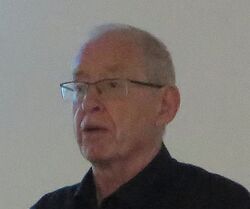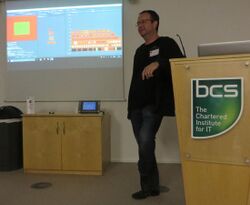EVA Conferences
Topic: Organization
 From HandWiki - Reading time: 3 min
From HandWiki - Reading time: 3 min
The Electronic Visualisation and the Arts conferences (EVA Conferences for short, aka Electronic Information, the Visual Arts and Beyond) are a series of international interdisciplinary conferences mainly in Europe, but also elsewhere in the world, for people interested in the application of information technology to the cultural and especially the visual arts field, including art galleries and museums.[1]
Overview
Started in London (UK), there are now EVA conferences in Berlin (Germany), Florence (Italy), Jerusalem (Israel), St Petersburg (formerly in Moscow, Russia), Australasia (first time in Canberra, Australia in 2016) and other major cities.[2] The first EVA Conference was held at Imperial College, London in 1990,[3] organised by the founders James Hemsley, Kirk Martinez, and Anthony Hamber.
The conferences have been overseen by EVA Conferences International, based in London. Conference proceedings are published.[4][5] In addition, two collected volumes of revised papers are available.[6][7]
EVA London
The EVA London conference, founded in 1990 by James Hemsley,[8] is now organised through the Computer Arts Society (CAS), a Specialist Group of the British Computer Society (BCS) each July at the BCS London office.[9]
Some V&A Digital Futures events organised by the Victoria and Albert Museum are held in conjunction with EVA London.[10][11] In 2016, it hosted an event for the Lumen Prize, an annual award for digital art.[12] The proceedings have published through the BCS Electronic Workshops in Computing (eWiC) series since 2008 and are indexed by DBLP.[13]
See also
- Computer Arts Society
- ICHIM
- Lumen Prize
- Museums and the Web
- V&A Digital Futures
References
- ↑ Online: Electronic imaging, the visual arts and beyond. New Heritage, 05.02:7, October 2002.
- ↑ "EVA Conferences International". EVA London Concerence. http://www.eva-london.org/international/. Retrieved 11 June 2017.
- ↑ "News and Events: European session at the EVA 2002". Cultivate Interactive (Archive.org) Issue 7. July 2002. Archived from the original on 23 July 2002. https://web.archive.org/web/20020723184553/http://www.cultivate-int.org/issue7/mag-news/.
- ↑ EVA London 2007 Conference Proceedings, London College of Communication, University of the Arts London, UK, 11–13 July 2007. EVA Conferences International, 2007. ISBN:0-9543146-8-9.
- ↑ EVA 2006 Florence Conference Proceedings, Florence, Italy, 3–7 April 2006. Pitagora Editrice Bologna. ISBN:88-371-1610-1.
- ↑ Digital Applications for Cultural and Heritage Institutions. Ashgate Publishing. 2005. ISBN 978-0-7546-3359-4.
- ↑ Electronic Visualisation in Arts and Culture. Springer Series on Cultural Computing. Springer. 2013. ISBN 978-1-4471-5406-8. https://www.springer.com/computer/image+processing/book/978-1-4471-5405-1.
- ↑ Hemsley, James (2013). "The EVA Conference 1990–2012: Personal Reflections". Electronic Visualisation in Arts and Culture. Springer Series on Cultural Computing. Springer. pp. 1–5. https://www.springer.com/gb/book/9781447154051.
- ↑ EVA London, EVA Conferences International.
- ↑ "Digital Futures". UK: EVA London. 2016. http://www.eva-london.org/eva-london-2016/programme/digital-futures. Retrieved 31 October 2016.
- ↑ "V & A Digital Futures meets EVA London", EVA London 2015 Conference Proceedings, Electronic Workshops in Computing (eWiC), London, UK: BCS, 2015, pp. 1–16, http://ewic.bcs.org/category/18483#v&a
- ↑ "EVA, London". The Lumen Prize. July 2016. http://lumenprize.com/exhibitionpage/eva. Retrieved 28 October 2016.
- ↑ "Electronic Visualisation and the Arts". DBLP. http://dblp2.uni-trier.de/db/conf/eva/. Retrieved 28 October 2016.
External links
- EVA Conferences International website
- EVA Berlin online in open access at the University Library Heidelberg.
39 views | Status: cached on July 18 2024 04:53:06
↧ Download this article as ZWI file
 KSF
KSF


